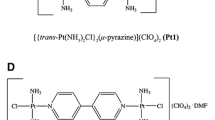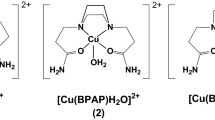Abstract
Purpose
Treatment for lung cancer is still far from satisfying rates. Therefore, there is a need for novel anticancer agents. For this purpose, novel platinum and palladium complexes {[Pd(sac)(terpy)](sac)·4H2O (Complex 1), [Pt(sac)(terpy)](sac)·5H2O (Complex 2), [PdCl(terpy)](sac)·2H2O (Complex 3), [PtCl(terpy)](sac)·2H2O (Complex 4)} have been tested against three different non-small cell lung cancer cell lines (A549, H1299, PC-3).
Methods
Growth-inhibiting effects have been tested by the MTT and ATP viability assays. Apoptosis has been detected by the caspase-cleaved cytokeratin 18 (M30-antigen) assay. Necrosis has been detected by staining the cells with fluorescent dyes. Mitotic index has been calculated by counting the mitotic figures after staining with hematoxylin.
Results
The complex 3 exhibited significant anti-growth effects, and its anti-growth effect was more powerful than that of cisplatin that is a standard chemotherapeutic agent for this type of cancer. The complexes did not induce apoptosis, while necrosis clearly took place.
Conclusions
Novel Pd(II) complex ([PdCl(terpy)](sac)·2H2O) seems to represent a potentially active drug against non-small cell lung cancer cell lines, and further studies in vivo are warranted.








Similar content being viewed by others
References
Abu-Surrah AS, Al-Sa’doni HH, Abdalla MY (2008) Palladium-based chemotherapeutic agents: routes toward complexes with good antitumor activity. Cancer Ther 6:1–10
Al-Masoudi NA, Abdullah BH, Essa AH, Loddo R, LaColla P (2010) Platinum and palladium-triazole complexes as highly potential antitumor agents. Arch Pharm (Weinheim) 343:222–227
Andreotti PE, Cree IA, Kurbacher CM, Hartmann DM, Linder D, Harel G et al (1995) Chemosensitivity testing of human tumors using a microplate adenosine triphosphate luminescence assay: clinical correlation for cisplatin resistance of ovarian carcinoma. Cancer Res 55:5276–5282
Budzisz E, Krajewska U, Rózalski M (2004) Cytotoxic and proapoptotic effects of new Pd(II) and Pt(II)-complexes with 3-ethanimidoyl-2-methoxy-2H–1, 2-benzoxaphosphinin-4-ol-2-oxide. Pol J Pharmacol 56:473–478
Caires ACF, Almeida ET, Mauro AE, Hemerly JP, Valentini SR (1999) Quim. Nova 22:329–334
Clark JS, Faisal A, Baliga R, Nagamine Y, Arany I (2010) Cisplatin induces apoptosis through the ERK-p66shc pathway in renal proximal tubule cells. Cancer Lett 297:165–170
Cooley ME, Davis L, Abrahm J (1994) Cisplatin: a clinical review. Part II–Nursing assessment and management of side effects of cisplatin. Cancer Nurs 17:283–293
Cummings SD (2009) Platinum complexes of terpyridine: interaction and reactivity with biomolecules. Coord Chem Rev 253:1495–1516
De Mier-Vinue J, Lorenzo J, Montana AM, Moreno V, Aviles FX (2008) Synthesis, DNA interaction and cytotoxicity studies of cis-{[1, 2 bis(aminomethyl)cyclohexane]dihalo} platinum(II) complexes. J Inorg Biochem 102:973–987
Divsalar A, Saboury AA, Mansoori-Torshizi H, Ahmad F (2010) Design, synthesis, and biological evaluation of a new palladium(II) complex: beta-lactoglobulin and K562 as targets. J Phys Chem B 114:3639–3647
Eryazici I, Moorefield CN, Newkome GR (2008) Square-planar Pd(II), Pt(II), and Au(III) terpyridine complexes: their syntheses, physical properties, supramolecular constructs, and biomedical activities. Chem Rev 108:1834–1895
Gao J, Liu YG, Zingaro RA (2009) Cytotoxic activities, cellular uptake, gene regulation, and optical imaging of novel platinum(II) complexes. Chem Res Toxicol 22:1705–1712
Gao EJ, Wang L, Zhu MC, Liu L, Zhang WZ (2010a) Synthesis, characterization, interaction with DNA and cytotoxicity in vitro of the complexes [M(dmphen)(CO3)].H2O [M = Pt(II), Pd(II)]. Eur J Med Chem 45:311–316
Gao EJ, Wang KH, Zhu MC, Liu L (2010b) Hairpin-shaped tetranuclear palladium(II) complex: synthesis, crystal structure, DNA binding and cytotoxicity activity studies. Eur J Med Chem 45:2784–2790
Garoufis A, Hadjikakou SK, Hadjiliadis N (2009) Palladium coordination compounds as anti-viral, anti-fungal, anti-microbial and anti-tumor agents. Coord Chem Rev 253:1384–1397
Gligorijević N, Todorović T, Radulović S, Sladić D, Filipović N, Godevac D, Jeremić D, Andelković K (2009) Synthesis and characterization of new Pt(II) and Pd(II) complexes with 2-quinolinecarboxaldehyde selenosemicarbazone: cytotoxic activity evaluation of Cd(II), Zn(II), Ni(II), Pt(II) and Pd(II) complexes with heteroaromatic selenosemicarbazones. Eur J Med Chem 44:1623–1629
Graham RD, Williams DR (1979) The synthesis and screening for anti-bacterial, -cancer, -fungicidal and -viral activities of some complexes of palladium and nickel. J Inorg Nucl Chem 41:1245–1249
Guney E, Yilmaz VT, Sengul A, Buyukgungor O (2010) Platinum(II) and palladium(II) saccharinato complexes with 2, 20:60, 200-terpyridine: Synthesis, characterization, crystal structures, photoluminescence and thermal studies. Inorganica Chim Acta 363:438–448
Guney E, Yilmaz VT, Ari F, Buyukgungor O, Ulukaya E (2011) Synthesis, characterization, structures and cytotoxic activity of palladium(II) and platinum(II) complexes containing bis(2-pyridylmethyl)amine and saccharinate. Polyhedron 30:114–122
Keter FK, Kanyanda S, Lyantagaye SS, Darkwa J, Rees DJ, Meyer M (2008) In vitro evaluation of dichloro-bis(pyrazole)palladium(II) and dicloro- bis(pyrazole)platinum(II) complexes as anticancer agents. Cancer Chemother Pharmacol 63:127–138
Kuduk-Jaworska J, Puszko A, Kubiak M, Pełczyńska M (2004) Synthesis, structural, physico-chemical and biological properties of new palladium(II) complexes with 2, 6-dimethyl-4-nitropyridine. J Inorg Biochem 98:1447–1456
Liao Y, Lu X, Lu C, Li G, Jin Y, Tang H (2008) Selection of agents for prevention of cisplatin-induced hepatotoxicity. Pharmacol Res 57:125–131
Lin M, Wang X, Zhu J, Fan D, Zhang Y, Zhang J, Guo Z (2011) Cellular and biomolecular responses of human ovarian cancer cells to cytostatic dinuclear platinum(II) complexes. Apoptosis 16:288–300
Neves AP, da Silva GB, Vargas MD, Pinheiro CB, Visentin Ldo C, Filho JD, Araújo AJ, Costa-Lotufo LV, Pessoa C, de Moraes MO (2010) Novel platinum(II) complexes of 3-(aminomethyl)naphthoquinone Mannich bases: synthesis, crystal structure and cytotoxic activities. Dalton Trans 39:10203–10216
Park SJ, Wu CH, Gordon JD, Zhong X, Emami A, Safa AR (2004) Taxol induces caspase-10-dependent apoptosis. J Biol Chem 279:51057–51067
Rau T, van Eldik R (1996) In metal ions in biological systems. In: Sigel H, Sigel A (eds) Platinum and other metal coordination compounds in cancer chemotherapy. Marcel Dekker, New York, pp 339–378
Ruiz J, Villa MD, Cutillas N, López G, de Haro C, Bautista D, Moreno V, Valencia L (2008) Palladium(II) and platinum(II) organometallic complexes with 4, 7-dihydro-5-methyl-7-oxo[1, 2, 4]triazolo[1, 5-a]pyrimidine. Antitumor activity of the platinum compounds. Inorg Chem 47:4490–4505
Skinner R, Pearson AD, Coulthard MG, Skillen AW, Hodson AW, Goldfinch ME, Gibb I, Craft AW (1991) Assessment of chemotherapy-associated nephrotoxicity in children with cancer. Cancer Chemother Pharmacol 28:81–92
Tamasi G, Casolaro M, Magnani A, Sega A, Chiasserini L, Messori L, Gabbiani C, Valiahdi SM, Jakupec MA, Keppler BK, Hursthouse MB, Cini R (2010) New platinum-oxicam complexes as anti-cancer drugs. Synthesis, characterization, release studies from smart hydrogels, evaluation of reactivity with selected proteins and cytotoxic activity in vitro. J Inorg Biochem 104:799–814
Trevisan A, Marzano C, Cristofori P, Borella Venturini M, Giovagnini L, Fregona D (2002) Synthesis of a palladium(II)-dithiocarbamate complex: biological assay and nephrotoxicity in rats. Arch Toxicol 76:262–268
Ulukaya E, Ozdikicioglu F, Oral AY, Demirci M (2008) The MTT assay yields a relatively lower result of growth inhibition than the ATP assay depending on the chemotherapeutic drugs tested. Toxicol In Vitro 22:232–239
Van Cruchten S, Van Den Broeck W (2002) Morphological and biochemical aspects of apoptosis, oncosis and necrosis. Anat Histol Embryol 31:214–223
Vo V, Kabuloglu-Karayusuf ZG, Carper SW, Bennett BL, Evilia C (2010) Novel 4, 4′-diether-2, 2′-bipyridine cisplatin analogues are more effective than cisplatin at inducing apoptosis in cancer cell lines. Bioorg Med Chem 18:1163–1170
Vrzal R, Starha P, Dvorák Z, Trávnícek Z (2010) Evaluation of in vitro cytotoxicity and hepatotoxicity of platinum(II) and palladium(II) oxalato complexes with adenine derivatives as carrier ligands. J Inorg Biochem 104:1130–1132
Wang AH, Nathans J, van der Marel G, van Boom JH, Rich A (1978) Molecular structure of a double helical DNA fragment intercalator complex between deoxy CpG and a terpyridine platinum compound. Nature 276:471–474
Wong Y, Lippard SJ (1977) X-Ray crystal structure of a 2:2 chloroterpyridineplatinum (II)-adenosine-5′-monophosphate intercalation complex. J Chem Soc Chem Commun 824–825. doi:10.1039/C39770000824
Acknowledgments
We thank the Research Fund of Uludag University for providing us with the kits/chemicals.
Author information
Authors and Affiliations
Corresponding author
Rights and permissions
About this article
Cite this article
Ulukaya, E., Ari, F., Dimas, K. et al. Cell death-inducing effect of novel palladium(II) and platinum(II) complexes on non-small cell lung cancer cells in vitro. J Cancer Res Clin Oncol 137, 1425–1434 (2011). https://doi.org/10.1007/s00432-011-1021-1
Received:
Accepted:
Published:
Issue Date:
DOI: https://doi.org/10.1007/s00432-011-1021-1




